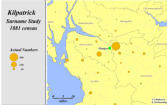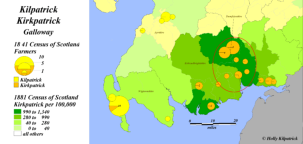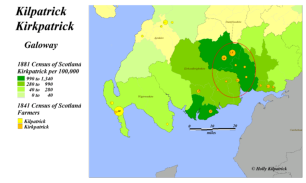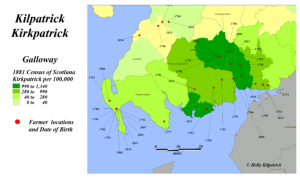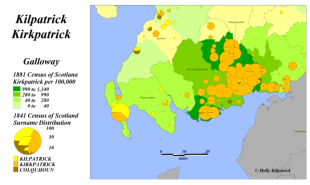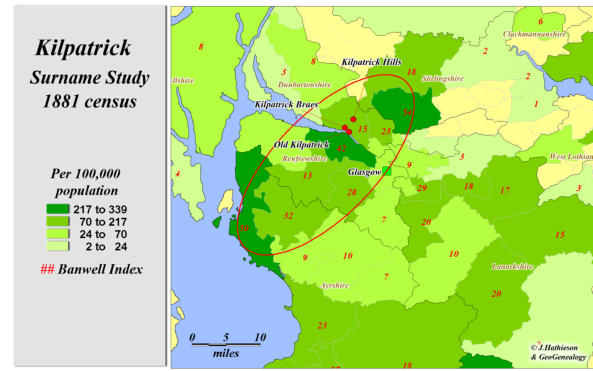



The Kilpatrick Surname Study


The 1881 Census of Scotland
Distribution and Intensity
The "contemporary distribution" (1881) of the Kilpatrick surname is in line with the etymological description. The surname is strongly localized in Dunbartonshire where we find the place name elements and parish boundaries. The surrounding counties of Renfrewshire and Ayrshire are also well represented. In the 18th and 19th centuries, industrialization and urbanization have distorted the historic pattern, with the proximity to Glasgow being a major factor. A further factor pointing to the Dunbartonshire origin can be gleaned from the Kilpatrick Family Tree YDNA Study. Numerous instances of matches with the surname Colhoun are found in the results. The distribution of the Calhoun surname is geographically coincident with the Kilpatrick surname. Both Calhoun and Colhoun, are variants of the surname Colquhoun. The Colquhoun clan territory overlaps in part the parish of Old Kilpatrick. The shared DNA would likely pre-date the adoption of surnames. Related individuals would eventually take surnames from different roots, some as members of a clan, others who resided near a church. Transcription confusion between Kilpatrick and Kirkpatrick likely took place n the homeland before surnames became fossilized. This could account for the presence of both surnames and the DNA overlap between the two surnames.Surname Intensity
As mentioned earlier, the contemporary distribution of surnames during the late 19th and early 20th centuries has been significantly influenced by industrialization and urbanization, making it challenging to trace a surname's historic origins accurately. An alternative method for examining this distribution involves displaying it as an area fill map, normalized per 100,000 population. The advantage of this approach is that the maps accurately represent the spatial extent of the distribution. A refinement of this method involves calculating a Banwell index, which compares the local intensity of surname occurrences with the national frequency. For instance, a Banwell index value of 5 would indicate that the intensity of occurrences in a particular Poor Law Union was five times higher than the national average for that surname. This approach helps eliminate urban bias and highlights two distinct regions: coastal Ayrshire and the counties bordering the River Clyde. When combined, these regions cover the historic homeland identified by Black in 'The Surnames of Scotland'."Farmers and the Distribution of Surnames
In 1890, H.B. Guppy published "Homes of Family Names in Great Britain," wherein he proposed a theory that farmers in the West of England could serve as identifiers of the homeland for local surnames. Remarkably simple yet insightful, Guppy utilized trade directories to analyze the distribution of surnames. His argument rested on the premise that farmers, being the most stable segment of the population, could pinpoint the homeland associated with a surname. While modern surname studies have generally confirmed Guppy's principle, allowances must be made to accommodate the gradual drift away from a surname's homeland over time. The surnames Kilpatrick and Kirkpatrick provide an excellent illustration of this principle.Kilpatrick/Kirkpatrick Farmers
A query of the 1841 Census of Scotland revealed 20 Kilpatrick and 29 Kirkpatrick farmers, with none appearing in the parishes of Old and New Kilpatrick. This highlights a limitation of Guppy's approach, as some farmers, whom we might term "ghost farmers," have departed the land without leaving evidence of their past presence. The majority of farmers are concentrated in Galloway, particularly in regions where Kirkpatrick and a small cluster of Kilpatricks are found. This aligns with the dominance of Kirkpatricks in West Dumfries in 1881, as indicated by the distribution of the Kirkpatrick population in 1841, which corresponds well with the 1881 area fill map. Kirkpatrick farmers are concentrated in northwest Dumfries, while the broader Kirkpatrick population is centered in southwest Dumfries-shire, closer to the coast and the Solway Firth. As noted by Davis Hey, younger populations tend to migrate away from farms to settle near market towns, such as coastal ports in this case. The information gleaned from the 1841 census of farmers allows us to trace their existence beyond the census itself, including their ages and possibly their birth locations. It is likely that they are the sons of farmers who preceded them. The question remains: how far back can these familial links be extended? It is reasonable to assume that farmers in this region were present in the latter half of the 18th century and almost certainly at the time of the plantation itself. However, the presence of a cluster of Kilpatricks and farmers in Wigtownshire requires further explanation. It is probable that these Kilpatricks are immigrants from County Down, which is less than 20 miles away across the narrow sea from Scotland. This will be explored in more detail when examining the Plantation of Ulster and settlement from Scotland to Ulster.
© Holly Kilpatrick


The Kilpatrick Surname Study
GeoGenealogy
